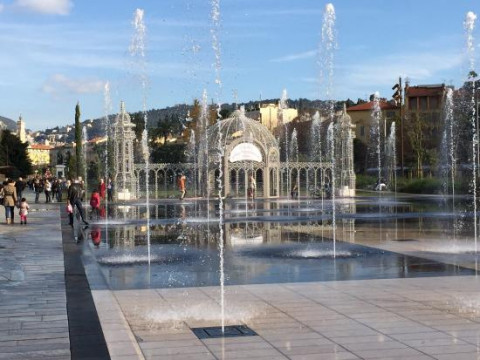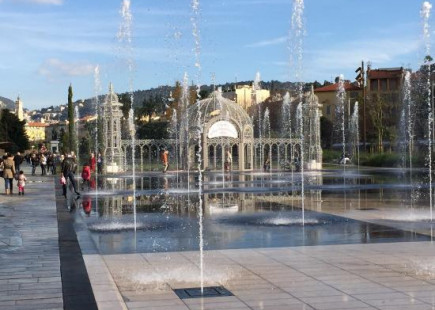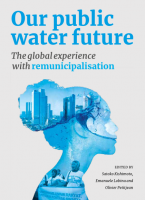Nice: building a public water company after 150 years of private management
Topics
Regions
This article was written for Eau publique, eau d´avenir, published June 2015(French edition of Our Public Water Future: The Global experience with remunicipalisation) and translated into English.
In March 2013, the councillors of Nice, the fifth largest city in France, and of the surrounding communes announced that the city’s water services would gradually shift towards public management.


TripAdvisor
Despite heated debate in France on private water management as well as several emblematic remunicipalisations, at the time, this announcement from a municipality with a reputation for being economically conservative, came as a surprise to many. Executives from the private provider, Veolia, spoke publicly of a “cold shower”. The company (formerly Générale des Eaux) had been in charge of Nice’s water management since the city’s water system was set up in 1864! (Sanitation services, on the other hand, have always been under public management) In other words, Nice’s water had never beenmanaged by the public. The most recent contract was signed in 1952 and had been renewed several times, with amendments.
The new public company (régie) Eau d’Azur was officially created in June 2013. The coastal towns of Beaulieu, Cap d'Ail, Eze and Villefranche joined the company in September 2014, before Nice itself on 4 February 2015. The already existent public companies in the metropolitan area were integrated into Eau d’Azur on January 1st 2015. Now 33 of Nice’s 49 municipalities, i.e. roughly 80% of the population, depend on Eau d’Azur for their water supply.
Upon closer inspection, the remunicipalisation of Nice should not have come as such a surprise. The city’s councillors had been conducting audits on the operation and performance of the water service for several years. They had succeeded in obtaining successive reductions in Nice’s water prices in 2009 and 2013. In 2008, the municipalities of Saint-André, Falicon and Trinité, part of the Nice métropole, did not renew their contract with Veolia and returned to public management. And in other sectors, Nice’s councillors had, over the previous years, already remunicipalised the city’s public transport system, the school cafeteria system, a swimming pool, the jazz festival and a nationally significant agricultural market.
Although promoting public water management may seem more of a progressive cause, many cities are in fact opting for water “remunicipalisation”, regardless of their political leaning. Unlike other politicians in France which have taken the remunicipalisation path, those in Nice (in particular, Christian Estrosi, Deputy Mayor of Nice and Chairman of the metropolitan area (métropole) and Hervé Paul, Chairman of the Water, Sanitation and Energy Commission and Chairman of Eau d’Azur) have not taken an absolutist stance in the public versus private debate, even though they claim to have made a “political choice”. Their public statements never fail to mention that there can be a place for private water management - alongside modern, public water companies.
Nice – unique in its kind
The main reason that Nice chose to take the path of water remunicipalisation was to assert a principle of ‘territorial solidarity’ within the whole of Nice’s metropolitan area. Nice Côte d’Azur, which was the first “metropolitan area” created in France, on 1 January 2012, is unique in that it extends up to the alpine peaks of the Mercantour National Park and all the way to the Mediterranean Sea [1]. 80% of its land mass is located in rural or mountainous areas. It includes ski resorts (Isola 2000 and Auron) as well as seaside resorts, the city of Nice itself and medium- and high-altitude villages inland. In addition, the metropolitan area
almost exactly matches a single catchment area, that of the Tinée and Vésubie, two tributaries of the Var. There are also strong historical ties between Nice’s urban centre and villages inland; all the prominent families in Nice, including that of the mayor Christian Estrosi, originate from mountain towns and villages. Historically, the only channel that connected these villages to the city of Nice was the deep valleys along the rivers down the mountain. This backdrop of interdependence illustrates the symbolic importance of water in the development of the métropole of Nice.
According to the councillors of Nice Côte d’Azur, the primary reason for the shift towards remunicipalisation was that private management was “unsuitable” for an area of this size and of such a varied landscape. Private management was ill-suited to promote solidaritybased relationships and the kind of “pooling of resources” between the metropolitan area’s municipalities that they wanted. Private management was not particularly socially acceptable either. In mountain villages, where people are very attached to the idea of a local public service, control of water is a very sensitive issue. Given that it can already be difficult for the people of these villages to accept a new public company, managed by ‘city people’, which undertakes to modernise the water system and instigate efficiency measures such as installing water meters, such changes would have been simply out of the question with a private operator.
Investments
As well as issues related to the particularity of the land, another driver of remunicipalisation was of course the will to introduce greater political control over water services, particularly in regards to the long-term evolution of water rates. Councillors wanted to be a able to use the public company’s revenue stream to maintain infrastructure and improve the quality and user-friendliness of the service, instead of distributing profits to shareholders. The water service of the Nice metropolitan area face several challenges. The first of these is ensuring a steady water supply, particularly over the summer months when the population doubles with the influx of holidaymakers. In order to mitigate potential risks, particularly in case of dry summers, the public company concentrates on reducing leaks and conserving water resources. Although leaks are not a major problem on the coast, there is a relatively high level of water loss inland and in mountain areas, due to the age of water pipes, some of which are over 100 years old. Key investments include installing individual water meters, removing lead pipes, and establishing or upgrading treatment plants in mountain towns and villages. The new public company has thus committed to carry out the work necessary to address these issues and modernise the network.
For the sake of symbol, councillors had hoped to announce a cut in the price of water when the new public company took over in February 2015. But Christian Estrosi and Hervé Paul had already succeeded in obtaining (gradually) a 30% drop in water prices over the previous years. In order to cover investment costs, they finally decided to leave overall revenue at its current level while introducing a progressive pricing system. The price of water in Nice dropped nearly 30% for primary and secondary consumption bands (60 and 120 cubic meters per year respectively). However, for large water consumers (hotels or collective ownerships without individual water meters, i.e. 12% of users according to Eau d’Azur), there was a slight rise in the price of water. Overall, for the same revenue, spending on
investments has doubled compared to that spent under private management: the public company will invest 105 million euros over a five-year period, i.e. an average of 21 million euros each year, which is double what was spent over the previous five years. Eau d’Azur is now planning on standardising its level of service and its water prices throughout the metropolitan area, which may take some time.
The distinctiveness of the Nice water network, with its mountainous landscape, has also inspired innovative water and energy policies. Even before the remunicipalisation, Hervé Paul had prompted Veolia to install hydroelectric turbines on the treated water pipes running from the Super Rimiez water purification plant, located 220 metres above sea level. The public company is also committed to building a new hydroelectric power plant on a major channel that transports raw water. Once this new equipment is installed, the public water company will become ‘energy-positive’.
A smooth transition?
Nice’s water municipalisation process has been quite smooth compared to previous experiences. Councillors chose not to openly question the management of the former provider. Following the example of Paris’s remunicipalisation process, the public company has signed temporary contracts with Veolia that expire at the end of 2016. These concern certain key areas of service management such as customer management software. Nice also signed a temporary two-year contract granting it access to Veolia’s central purchasing department. This will allow it to access Veolia’s preferential rates, and means it won’t have to go through potentially hundreds of different tenders. According to Eau d’Azur’s executives, Veolia has more or less gone along with the remunicipalisation, aware that it did
not have much choice in the matter. Veolia probably also hopes to keep on taking on subcontracting work once the temporary contracts have expired. Eau d’Azur, however, is planning on becoming fully autonomous by 2017.
The relatively painless shift from private to public has certainly made it easier to integrate the previous operator’s employees. The social aspect of remunicipalisation is particularly difficult to manage in France. As well as the valid concerns of employees’ regarding potential job cuts or a levelling down in salaries or working conditions, there is also the issue of defining the scope of the new work force. As major groups like Veolia pool resources and services, a new public company not only has to retain employees that work “on the ground” in their city, but also a section of those that belong to pooled services. However, there is no clear legislation regarding the transition of employees from a private to a public operator. Nice’s councillors succeeded in neutralising potential conflicts with employees by announcing at the outset – after an important rally by the local union - that the remunicipalisation process would involve establishing a collective agreement that set out provisions for the transfer of employees from the public to the private company. There were also meetings held with staff representatives once a week for two years so as to include them in the decisions about the new public company’s structure. The fact that Veolia was at the same time undergoing a series of restructuring plans and jobs cuts made it easier to convince its previous employees to join the new public company.
There currently remain 16 towns in Nice’s metropolitan area whose private management contracts have not expired. It is likely that those towns located inland, right in the middle of the area served by Eau d’Azur will also shift to public management once their contract expire in 2017. However it is not as clear-cut in the case of towns located on the coast, on the other side of the mouth of the Var, which has a completely separate network and separate water sources. These contracts will expire in 2019.
Collaboration and cooperation among public operators
Nice's water municipalisation process is an interesting illustration of the collective learning that can occur between operators of recently remunicipalised water services. As noted, Eau de Paris, and the way in which it was set up, served as an inspiring example for creating Nice’s own public company. The company both reproduced what worked in Paris and learned from what didn’t. Other ideas inspired by Paris included the drawing up of longterm performance-based contracts with local councils (contrats d’objectifs) and promoting the Eau d’Azur “brand” in order to encourage consumption of the network’s drinking water (which, as it descends directly down the mountain through deep valleys with very little agricultural or industrial activity, is of an excellent quality) over bottled water.
On the other hand, Nice’s public company has put less emphasis on citizen participation compared to Paris [2] and other cities, focussing instead on building cohesion between the mayors and councillors of the metropolitan area. This is due, in particular to the fact that Nice’s remunicipalisation was primarily a political decision. Unlike other cities such as Rennes or Montpellier, there was no particular NGO or civic movement that was pushing for water remunicipalisation. Eau d’Azur’s board of directors nevertheless includes a representative from the University of Nice, a consumer’s association representative, and a staff representative.
In turn, the successes of Nice’s remunicipalisation experience, particularly in regards to its integration of the previous private provider’s employees, inspired other cities such as Montpellier. France Eau Publique, the French association of public water operators, which Eau d’Azur immediately joined, played a critical role in facilitating such exchanges. Grenoble, Nice, Paris (and soon, Montpellier) represent a new generation of public water companies, which as well as being distinctively different from private operators, are also in some ways very different from the traditional régies that had resisted the privatisation push in France [3].
The leaders of Nice’s public operator are committed to taking collaboration even further. They wish to develop more advanced forms of cooperative resource sharing between public operators, for example, in the area of purchasing groups and client management software, which are critical areas for water services. Only cooperative resource sharing will allow them to finance the sort of IT tools they need, independently of the private companies. Several water operators that belong to France Eau Publique have already begun thinking along these lines. The wheels have been set in motion.
Olivier Petitjean is French writer and researcher, currently the chief editor at the Multinationals Observatory, an investigative website on French transnational corporations.
End Notes
[1] Before the “metropolitan area” was created, there existed a Nice Côte d’Azur urban community, which comprised only coastal and inland cities. Since the introduction of a new law in 2010, major French cities can now create a “metropolitan area” (métropole), which allows a more integrated service management. As part of the transition to the status of “metropolitan area”, Nice absorbed three former ‘urban communities’ in mountain areas.
[2] See (in this book) the interview with Anne Le Strat on public participation in Paris and the creation of the Citizens’ Water Observatory.
[3] All these new public companies have opted for the legal status of “régie à personnalité morale et autonomie financière” (public companies with moral personality and financial autonomy) which allows for greater independence and greater transparency. Unlike a number of traditional régies, their employees are not formal civil servants but have private sector-type employment contracts. It should be noted that when water servuces are returning to public management, unions now also tend to prefer the legal status of a “régie à personnalité morale et autonomie financière”.

